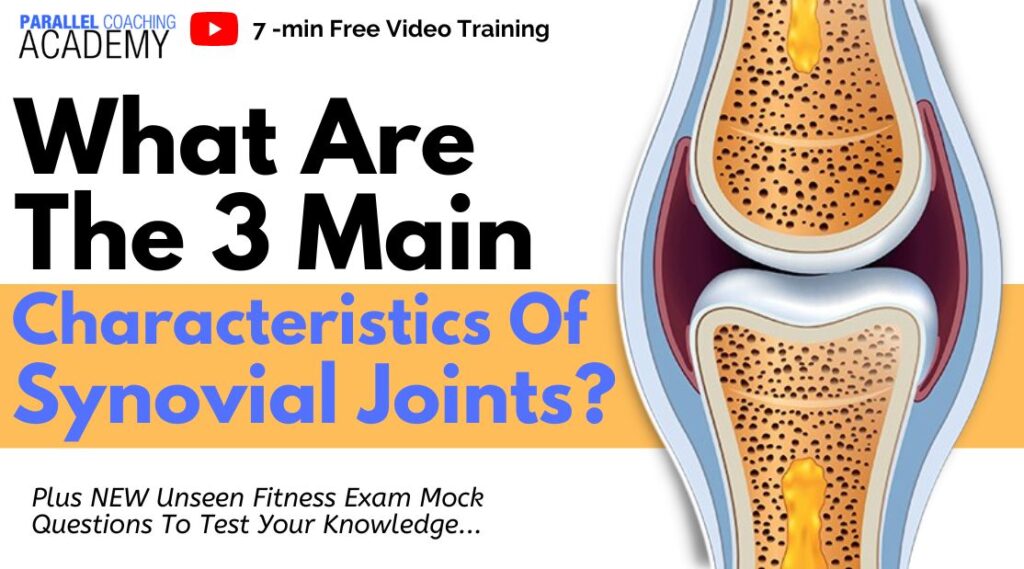As part of your Level 2 Anatomy exam, you’ll need to know the three main characteristics of synovial joints. This is one of many sub-sections within the skeletal system knowledge you need to know for your exam. In this blog you’ll learn:
- 8-minute video on the 3 main characteristics of synovial joints
- What are synovial joints?
- What you need to know for your Level 2 anatomy exam
- The three main characteristics of synovial joints
- Three mock questions to test your knowledge
Start by watching the video and then check your knowledge using the mock questions
Watch: 8-minute video on the three main characteristics of synovial joints
What Are Synovial Joints?
As part of the Level 2 Anatomy and Physiology exam, you need to learn 8 modules of content. One of these modules is the skeletal system, which includes bones and joints.
Joints are the locations where bones meet bones. There are three types of joints: synovial, cartilaginous and fused.
Synovial joints are the most common of all joints. They are freely moveable to allow for joint actions and motion. They have a unique structure which has three main characteristics:
- Synovial Fluid
- Articular Cartilage
- Reinforcing Ligaments
Let’s explore these in more detail:
1. Synovial Fluid
Synovial fluid lubricates the articulating bones during movement. This keeps the joint action smooth and cushions impact.
It helps to reduce friction and wear in the joints, and also provides nutrients and oxygen to the cartilage that lines the joints. The synovial fluid is contained in a synovial cavity. The synovial cavity, is also known as the joint cavity.
The fluid is produced by the synovial membrane, which surrounds the joint.
Understanding this feature of synovial joints will improve your programming. An effective client warm-up includes mobility exercises, to activate the synovial fluid. A gradual pulse raise will also raise the temperature of the joint and make the fluid more malleable.
Once the synovial fluid has been used it is reabsorbed into the bloodstream.
2. Articular Cartilage
A key feature of every type of joint is that two or more bones meet at the joint. Articular cartilage is a type of connective tissue that covers the surface of bones. It is a smooth, white tissue that is very durable and allows the bones to move easily against each other without causing pain or damage.
The cartilage has a gel-like consistency that helps it to withstand compressive loads. Articular cartilage is essential for the normal function of joints and helps to distribute the forces that are applied to the joint.
It also helps to reduce the wear and tear on the bones and helps to absorb shock.
Poor joint alignment can lead to uneven loading of the joint. This can lead to wear and tear across the articular cartilage. Leading to joint pain and stiffness, and ultimately leading to osteoarthritis.
This highlights the importance of correct posture and joint alignment during exercise.
3. Reinforcing ligaments
Ligaments are strong, fibrous connective tissues that connect bones to other bones. In a synovial joint, ligaments play an important role in providing stability to the joint and limiting the range of motion.
They connect the bones that make up the joint and help to hold the bones in place, preventing them from moving too far in any one direction.
Ligaments are usually composed of collagen fibers and are very strong and durable, but also flexible. They are designed to withstand the forces and to help protect the bones from injury.
Level 2 Anatomy Synovial Joint Mock Questions:
Q1. Which of the following is a characteristic of the Synovial Joint?
A. Synthesis Fluid
B. Mobilising Fluid
C. Synovial Fluid
D. Joint Oil
Q2. Which is not a type of joint?
A. Fused Joint
B. Cartilaginous Joint
C. Synovial Joint
D. Appendicular Joint
Q3. What is a the function of ligaments in a synovial joint?
A. Increased Stability
B. Increased Flexibility
C. Increased ROM
D. Increased Mobilisation
Answers to the mock questions are :
Question 1= C, Question 2 = D, Question 3 = A
If you want more mock questions like this, then you can download more Free Mock Questions: DOWNLOAD NOW
Need More Help with your Level 2 Anatomy Revision?
For Trainee FITPROS Taking Their L2 Anatomy & Physiology Exam.
Learn, Revise & Pass Your Level 2 Anatomy & Physiology Exam In Under 10-hours
(Without Having To Spend Hours Revising Or Feeling Overwhelmed)
If you want to get your revision structured, learn everything you need to know, and feel confident on exam day, then click the link below:
https://courses.parallelcoaching.co.uk/products/level-2-anatomy-and-physiology-revision-bootcamp

Dedicated to More
Hayley “Three Main Characteristics Of Synovial Joints” Bergman
Parallel Coaching
P.S. You can also find us on the following platforms:
Instagram: Follow Now
Facebook: Like Our Page
Twitter: Tweet Us
YouTube: Subscribe Here
More Skeletal System Blogs: HERE

